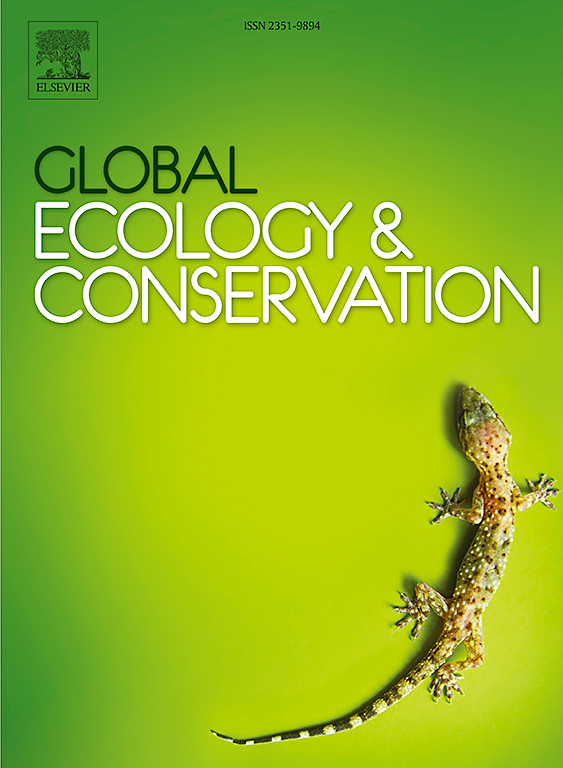Constructing an ecological network integrating avian biodiversity and ecosystem services in highly urbanized areas: A Case Study of Tianjin, China
IF 3.4
2区 环境科学与生态学
Q1 BIODIVERSITY CONSERVATION
引用次数: 0
Abstract
Rapid urbanization has caused significant biodiversity loss and a decline in ecosystem services, directly impacting human well-being. Developing an ecological network that integrates both biodiversity and ecosystem services could enhance the effectiveness of conservation efforts. However, research in this field remains limited, particularly in highly urbanized regions. This study focuses on Tianjin, China, and employs multiple models, including MaxEnt and InVEST, to identify priority conservation areas. A total of 228 protected bird species with diverse ecological niches were selected as biodiversity conservation targets. Water retention, soil retention, carbon sequestration, habitat quality, temperature regulation, and natural recreation were defined as targets for ecosystem service conservation. We analyzed the spatial relationship between avian biodiversity and ecosystem services and evaluated the conservation status of protected areas. The Minimum Cumulative Resistance (MCR) model was used to construct an ecological network that integrates avian biodiversity and ecosystem service hotspots. The results indicate that: (1) there is a synergistic relationship between avian biodiversity and both individual and comprehensive ecosystem services in Tianjin, supporting the feasibility of integrated conservation; (2) the coverage of protected areas over overlapping avian biodiversity and ecosystem service hotspots (core ecological zones) is only 37.7 %, revealing significant conservation gaps; (3) the ecological network identified 20 ecological sources and 31 important corridors, with spatial conservation management recommendations provided. This study incorporates multiple ecological protection indicators, which improve the ecological representativeness of sources within the network and provides valuable insights for constructing ecological networks in highly urbanized regions.
构建高度城市化地区鸟类生物多样性与生态系统服务一体化的生态网络——以天津市为例
快速城市化造成了生物多样性的严重丧失和生态系统服务的下降,直接影响到人类福祉。发展一个集生物多样性和生态系统服务于一体的生态网络可以提高保护工作的有效性。然而,这一领域的研究仍然有限,特别是在高度城市化的区域。本研究以中国天津市为研究对象,采用MaxEnt和InVEST等多种模型来确定优先保护区。选取生态位多样的受保护鸟类228种作为生物多样性保护对象。保水、保土、固碳、生境质量、温度调节和自然游憩是生态系统服务保护的目标。分析了鸟类生物多样性与生态系统服务的空间关系,评价了保护区的保护状况。利用最小累积阻力(MCR)模型构建了鸟类生物多样性与生态系统服务热点相结合的生态网络。结果表明:(1)天津市鸟类生物多样性与个体生态系统服务和综合生态系统服务之间存在协同关系,支持综合保护的可行性;(2)鸟类生物多样性与生态系统服务热点(核心生态区)重叠的保护区覆盖率仅为37.7 %,保护缺口明显;(3)生态网络确定了20个生态源和31个重要廊道,并提出了空间保护管理建议。该研究纳入了多种生态保护指标,提高了网络内资源的生态代表性,为高度城市化地区生态网络的构建提供了有价值的见解。
本文章由计算机程序翻译,如有差异,请以英文原文为准。
求助全文
约1分钟内获得全文
求助全文
来源期刊

Global Ecology and Conservation
Agricultural and Biological Sciences-Ecology, Evolution, Behavior and Systematics
CiteScore
8.10
自引率
5.00%
发文量
346
审稿时长
83 days
期刊介绍:
Global Ecology and Conservation is a peer-reviewed, open-access journal covering all sub-disciplines of ecological and conservation science: from theory to practice, from molecules to ecosystems, from regional to global. The fields covered include: organismal, population, community, and ecosystem ecology; physiological, evolutionary, and behavioral ecology; and conservation science.
 求助内容:
求助内容: 应助结果提醒方式:
应助结果提醒方式:


